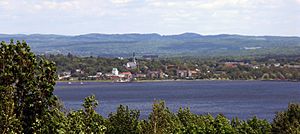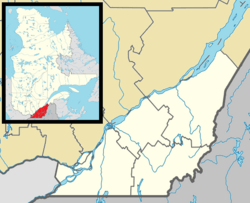Magog, Quebec facts for kids
Quick facts for kids
Magog
|
|||
|---|---|---|---|
|
City
|
|||

The skyline of the city of Magog
|
|||
|
|||
| Motto(s):
Fidelitate et Labore(Latin)
"Through faithfulness and labour" |
|||

Location within Memphrémagog RCM
|
|||
| Country | Canada | ||
| Province | Quebec | ||
| Region | Estrie | ||
| RCM | Memphrémagog | ||
| Constituted | October 9, 2002 | ||
| Area | |||
| • City | 167.50 km2 (64.67 sq mi) | ||
| • Land | 144.19 km2 (55.67 sq mi) | ||
| • Urban | 19.57 km2 (7.56 sq mi) | ||
| Population
(2011)
|
|||
| • City | 25,358 | ||
| • Density | 175.9/km2 (456/sq mi) | ||
| • Urban | 22,222 | ||
| • Pop 2006–2011 | |||
| • Dwellings | 13,605 | ||
| Time zone | UTC−5 (EST) | ||
| • Summer (DST) | UTC−4 (EDT) | ||
| Postal code(s) |
J1X
|
||
| Area code(s) | 819 and 873 | ||
| Highways |
|||
Magog is a city in southeastern Quebec, Canada. It is located about 120 kilometers (75 miles) east of Montreal. The city sits where Lake Memphremagog, the Rivière aux Cerises, and the Magog River meet.
Magog is an important center for industry and tourism in the Memphremagog area. It is also part of the beautiful Eastern Townships tourist region. In 2002, the City of Magog joined with the Township of Magog and the Village of Omerville to form the city we know today.
Contents
What's in a Name? The Meaning of Magog
The name "Memphremagog" comes from the Abenaki language, spoken by the Indigenous people of this region. The Abenaki word mamhlawbagak means "large expanse of water" or "vast lake."
It is believed that "Magog" is a shorter version of the lake's name. Another idea is that it comes from namagok, which means "the lake where there is brook trout." Some people even think the name might come from ancient stories or a city with the same name.
Magog's Past: A Look at History
The Abenaki people were the first to live in this area. They had visited Lake Memphremagog and its rivers for a very long time. White settlers began to arrive in 1776. These were Loyalists, people who supported the British during the American Revolution. They moved from nearby Vermont.
They called the area "The Outlet." This name referred to the water flowing from the lake into the Magog River.
Ralph Merry: The Founder of Magog
Ralph Merry is known as the founding father of Magog. He was an American Revolutionary who moved to Lower Canada in 1799. He settled in Bolton, which is west of the lake.
Merry bought many nearby land lots, including the village of The Outlet. He became its mayor, a judge, and helped develop the area. In 1821, he built a house there. This house is the oldest one still standing in the city today.
The area was officially named Magog in 1855.
From Textiles to Tourism: Magog's Economy Changes
In the late 1800s and through the 1900s, Magog's economy mainly depended on the textile industry. A large cotton mill, run by Dominion Textile, was the most important business.
However, in the 1960s and 1970s, the city worked to make its economy more diverse. This meant adding new types of businesses. Tourism, services, and the growth of an industrial park helped Magog's economy become stronger and more varied.
In 2002, the City of Magog officially merged with the Township of Magog and the Village of Omerville. This was part of a larger plan to reorganize cities in Quebec.
People from Magog
Many interesting people have come from Magog, including:
- Rouville Beaudry – An activist for Quebec nationalism who served in the Quebec government.
- Pierre Bélanger – A volleyball player who competed in the 1976 Olympics.
- Nicolas Boulay – A player in the Canadian Football League.
- Reginald W. Buzzell – A U.S. Army brigadier general, who was born in Magog.
- Sonia Vachon – A well-known actress.
Magog's Location and Climate
Magog is located in southeastern Quebec, Canada. It is about 120 kilometers (75 miles) east of Montreal. The city is found where Lake Memphremagog, the Rivière aux Cerises, and the Magog River meet.
Magog is also close to the Canada-United States border. It is about 35 kilometers (21.8 miles) from the Derby Line–Stanstead border crossing station.
Magog's Weather
Magog experiences a varied climate throughout the year. Here is a summary of the weather conditions:
| Climate data for Magog | |||||||||||||
|---|---|---|---|---|---|---|---|---|---|---|---|---|---|
| Month | Jan | Feb | Mar | Apr | May | Jun | Jul | Aug | Sep | Oct | Nov | Dec | Year |
| Record high °C (°F) | 17 (63) |
15 (59) |
24 (75) |
29 (84) |
33.9 (93.0) |
33 (91) |
34.4 (93.9) |
33.3 (91.9) |
30.6 (87.1) |
27.2 (81.0) |
22.8 (73.0) |
18 (64) |
34.4 (93.9) |
| Mean daily maximum °C (°F) | −5.9 (21.4) |
−4 (25) |
1.7 (35.1) |
9.3 (48.7) |
17.5 (63.5) |
22.1 (71.8) |
24.5 (76.1) |
23.2 (73.8) |
18 (64) |
11.4 (52.5) |
3.9 (39.0) |
−2.7 (27.1) |
9.9 (49.8) |
| Daily mean °C (°F) | −10.4 (13.3) |
−8.8 (16.2) |
−2.8 (27.0) |
4.6 (40.3) |
12 (54) |
16.9 (62.4) |
19.4 (66.9) |
18.2 (64.8) |
13.3 (55.9) |
7.1 (44.8) |
0.5 (32.9) |
−6.7 (19.9) |
5.3 (41.5) |
| Mean daily minimum °C (°F) | −14.9 (5.2) |
−13.5 (7.7) |
−7.3 (18.9) |
−0.1 (31.8) |
6.4 (43.5) |
11.7 (53.1) |
14.3 (57.7) |
13.2 (55.8) |
8.6 (47.5) |
2.9 (37.2) |
−2.9 (26.8) |
−10.7 (12.7) |
0.6 (33.1) |
| Record low °C (°F) | −37.2 (−35.0) |
−38 (−36) |
−31.7 (−25.1) |
−17.2 (1.0) |
−6.1 (21.0) |
−2 (28) |
2 (36) |
0.6 (33.1) |
−5 (23) |
−8.9 (16.0) |
−20.6 (−5.1) |
−32.2 (−26.0) |
−38 (−36) |
| Average precipitation mm (inches) | 86.5 (3.41) |
62 (2.4) |
80.2 (3.16) |
81.7 (3.22) |
100.3 (3.95) |
110.4 (4.35) |
120.2 (4.73) |
120 (4.7) |
97.8 (3.85) |
95.6 (3.76) |
92.3 (3.63) |
87.6 (3.45) |
1,134.5 (44.67) |
| Source: Environment Canada | |||||||||||||
Magog's Population: Who Lives Here?
In 2021, the city of Magog had a population of 28,312 people. This was an increase of about 6.2% from 2016. The city has a land area of about 144.26 square kilometers (55.70 square miles). This means there were about 196 people living in each square kilometer in 2021.
Population Changes Over Time
Here's how Magog's population has changed over the years:
| Census Year | Population | Change (%) |
|---|---|---|
| 2011 | 25,358 | |
| 2006 | 23,880 | |
| 2002 (Merger) | 22,535 | |
| 2001 | 14,283 | |
| 1996 | 14,050 | |
| 1991 | 14,034 | N/A |
Note: The population jumped significantly in 2002 because the City of Magog merged with the Township of Magog and the Village of Omerville.
Languages Spoken in Magog
"Mother tongue" means the first language a person learned at home. Here are the main languages spoken by people in Magog in 2011:
| Language | Number of People | Percentage (%) |
|---|---|---|
| French only | 22,975 | 92.2% |
| English only | 1,390 | 5.6% |
| Both English and French | 255 | 1.0% |
| Non-official languages | 270 | 1.1% |
| French and non-official language | 20 | 0.08% |
| English and non-official language | 5 | 0.02% |
| English, French and non-official language | 5 | 0.02% |
Magog's Economy: How People Make a Living
Magog is the main economic hub for the Memphremagog region.
Industries in Magog
For many years, Magog was known as a "one-industry town." This meant that most jobs were in the textile industry. The Dominion Textile company made cotton goods here. While the main factory is still in Magog, it now has fewer employees and mainly makes pillows.
Tourism: A Growing Industry
Magog is a popular place for vacations and tourism. Many shops and services in the city are there to help visitors and tourists. The beautiful lake and the nearby Mount Orford are big attractions for people visiting Magog.
See also
 In Spanish: Magog (Quebec) para niños
In Spanish: Magog (Quebec) para niños



